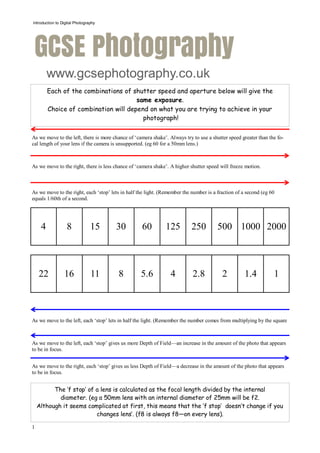Shutter speeds and apertures for tes
- 1. Introduction to Digital Photography www.gcsephotography.co.uk Each of the combinations of shutter speed and aperture below will give the same exposure. Choice of combination will depend on what you are trying to achieve in your photograph! As we move to the left, there is more chance of ŌĆścamera shakeŌĆÖ. Always try to use a shutter speed greater than the fo- cal length of your lens if the camera is unsupported. (eg 60 for a 50mm lens.) As we move to the right, there is less chance of ŌĆścamera shakeŌĆÖ. A higher shutter speed will freeze motion. As we move to the right, each ŌĆśstopŌĆÖ lets in half the light. (Remember the number is a fraction of a second (eg 60 equals 1/60th of a second. 4 8 15 30 60 125 250 500 1000 2000 22 16 11 8 5.6 4 2.8 2 1.4 1 As we move to the left, each ŌĆśstopŌĆÖ lets in half the light. (Remember the number comes from multiplying by the square As we move to the left, each ŌĆśstopŌĆÖ gives us more Depth of FieldŌĆöan increase in the amount of the photo that appears to be in focus. As we move to the right, each ŌĆśstopŌĆÖ gives us less Depth of FieldŌĆöa decrease in the amount of the photo that appears to be in focus. The ŌĆśf stopŌĆÖ of a lens is calculated as the focal length divided by the internal diameter. (eg a 50mm lens with an internal diameter of 25mm will be f2. Although it seems complicated at first, this means that the ŌĆśf stopŌĆÖ doesnŌĆÖt change if you changes lensŌĆÖ. (f8 is always f8ŌĆöon every lens). 1

